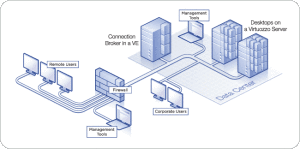 Virtual desktop infrastructure (VDI) is designed to deliver virtual desktops to client computers over a network from a centralised source. With traditional VDI, you create a master image (reference computer, or core) to use for all clients, then personalise images as needed.
Virtual desktop infrastructure (VDI) is designed to deliver virtual desktops to client computers over a network from a centralised source. With traditional VDI, you create a master image (reference computer, or core) to use for all clients, then personalise images as needed.
The process of distributing patches and updates is simplified because you only have to update images, not every physical desktop. Plus, you can push desktops across a variety of platforms and devices, from desktop PCs to thin clients and mobile devices.
VDI offers numerous benefits, mainly in the form of simplified desktop management and fewer hardware purchases. This, in turn, can lead to reduced capital expenditures and operating costs. When implemented properly, some organisations report that VDI reduced the cost of each desktop by up to 40 percent.
Today’s VDI products give you the option to extend the life of older client hardware. Legacy computers that ran Windows XP can be transformed into perfectly fine VDI thin clients for employees who don’t use CPU- and RAM-intensive applications.
Likewise, administrators spend less time managing physical client computers. Once VDI is implemented, all a client needs is a remote desktop connection to receive the virtual desktop. VDI also offers increased security and easier backups. Administrators can lock down images and prevent users from using external devices. With images and data stored in a server infrastructure, backups may be performed centrally on servers or storage devices rather than from client machines.
Some organisations adopt VDI to increase flexibility for end users. This doesn’t necessarily equate to cost savings. If your shop must react quickly to business changes, such as setting up a branch office or quickly changing locations in the event of an emergency, then rolling out VDI could be a good bet.
VDI Success Requires Adequate Networks, Servers and Storage
As good as VDI sounds, it’s not without some pitfalls. How many times have you been on the phone with a customer service rep and you hear, “Sorry, I’m having a problem accessing your records. My computer is slow today”?
Key challenges with VDI include network capacity, server capacity and adequate storage. VDI users can’t work offline, and they’ll be unable to perform their jobs if the network or server is down. IT needs to provide fast network or WAN links to push desktops and data to clients in real time, and its servers must be able to keep up that pace. Some organisations must also add serious storage capacity to house the number of images needed for VDI if users require numerous customised desktops.
Building the infrastructure required to support VDI, if it’s not already in place, can be expensive and must be considered when initially planning any VDI implementation. Another cost element is virtual desktop access licenses, which can run from just under $25 to about $100 per seat, depending on the vendor and solution selected.
That said, data deduplication can go a long way toward reducing storage requirements, usually by 70 percent or more. It also makes the use of solid state drives (SSDs) more viable for VDI images. While SSDs tend to have lower storage capacities than traditional disks, they also use fewer resources, which can lower the power and cooling requirements in a data centre.
VDI Implementation Needs Planning, Testing
Before diving into a full-scale VDI implementation, look at your organisation’s departments or business units and pick the one that’s best-suited to VDI. Remember, VDI is not a good fit for every user or business function; employees who need a lot of processing power or who demand local storage won’t benefit from VDI.
Begin with a pilot project and monitor the end-user experience. User satisfaction will be an important factor in the success of your project. If your solution doesn’t meet users’ performance expectations, it risks being shelved or abandoned.
VMware and Citrix are the VDI market leaders, but be sure to research other vendors for features that might work better in your environment. As you evaluate VDI options and narrow your choices, look for scalability and flexibility in case you decide to expand the implementation in the future.
It’s fairly simple to scale up from 50 users to 100 users, but things can get complicated after that. If your pilot is successful and you want to expand, but your solution doesn’t scale well, you might have to start over with a different architecture or solution – and, essentially, another pilot project.
VDI is acceptable only if provides a functional or financial benefit to your organization, where cost is usually the greatest factor. Consider both the initial and long-term costs, including licensing, storage and network infrastructure elements. This guide to calculating ROI from VDI is a good place to start. If you’ve already narrowed your choices down to a few preferred vendors, use their planning tools as well.
To reduce IT costs even further, employ VDI automation tools that streamline deployment, distribution and updates. If you run Hyper-V, for example, Microsoft provides a library of scripts with Windows Server 2012 R2, as well as Hyper-V Cmdlets for Windows PowerShell online. VirtualizationAdmin.com is also a useful information source on automation tools. Check out the HP Sizing Tool, tools for Microsoft App-V and VMWare Workstation and more.
Mobile users with ultra-thin laptops or tablets want to use those devices with all the perky features that come with them – so much so that they’re willing to bring their own devices to work. VDI can pose a challenge in forcing those users to access a virtual Windows desktop remotely.
For those particular users, your organisation could consider moving applications to the cloud, subscribing to Software-as-a-Service (SaaS), or virtualising applications that can then run on any device or platform. VMware Horizon Workspace, part of the Horizon Suite, is one option to provide mobile workers with VDI.
Another possibility is a hosted VDI solution, also known as Desktop-as-a-Service. With DaaS, you host virtual desktops in the cloud, either in-house in a private cloud or through some third-party provider.
The benefit of using a third party comes from offloading IT of the responsibility for maintaining back-end technology, such as load balancing, resource provisioning, and network problem-solving. Instead, IT can focus on managing clients, their virtual desktops and their applications.





